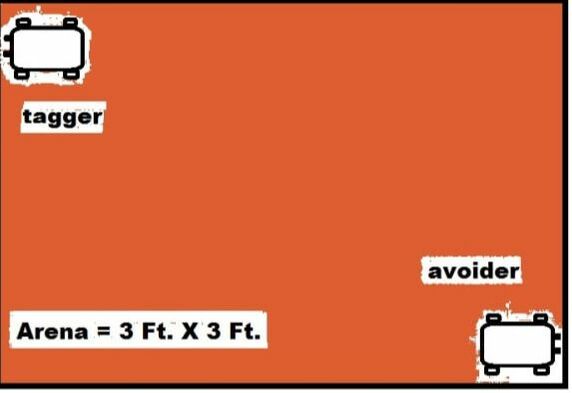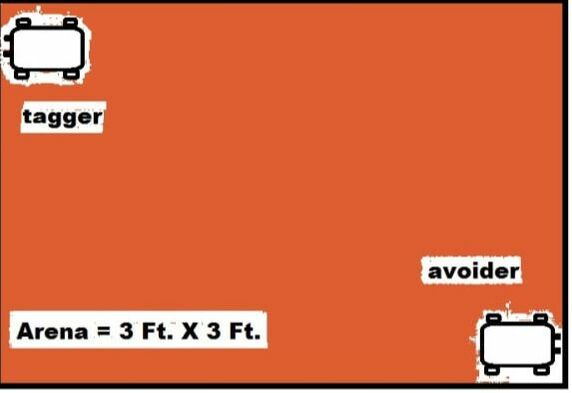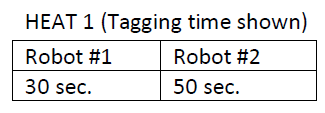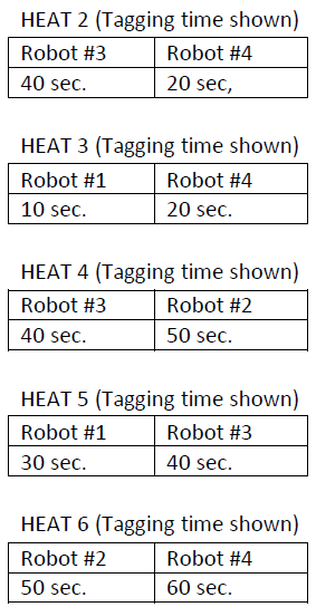|
Robot Tag Contest Rules (revision A)
|
| ||
1. Two robots at a time will be placed in a 3 foot square box. One is the “Tagger” and one is the “Avoider”.
(the contest floor is red/brown in color, and the arena edge is ¾” black electrical tape.)
(the contest floor is red/brown in color, and the arena edge is ¾” black electrical tape.)
2. Each robot will be a “Tagger” or an “Avoider” during a 2 minute contest (maximum). Then in round 2 the roles are swapped for a maximum of 2 minutes. The robot with lowest time to tag opponent is the winner of that HEAT.
3. Each robot starts by facing away from the other robot. Audience is asked to stay 3 foot away from the edge of the arena, to prevent ultrasonic sensing errors.
4. A stopwatch is started at the “GO” command of the judge. Elapsed time is recorded for the first Tagger of the round. Then, as the roles of Tagger and Avoider are switched, elapsed time is recorded for the second Tagger of that round. Robot with shortest time is the winner of the HEAT.
5. Physical parts of the robot can protrude outside the 3 foot box, while it turns direction.
6. Judges will determine if a robot got bumped by the other. So no touch sensors will be needed.
7. The next HEAT will commence with 2 new robots.
8. Each subsequent HEAT eventually pairs up every robot.
9. Anything goes, such as the speed, type of robot, or the shape of the robot.
10. If the judges desire, there can be a double elimination to give a second chance at winning, by entering each robot in at least 2 HEATS:
3. Each robot starts by facing away from the other robot. Audience is asked to stay 3 foot away from the edge of the arena, to prevent ultrasonic sensing errors.
4. A stopwatch is started at the “GO” command of the judge. Elapsed time is recorded for the first Tagger of the round. Then, as the roles of Tagger and Avoider are switched, elapsed time is recorded for the second Tagger of that round. Robot with shortest time is the winner of the HEAT.
5. Physical parts of the robot can protrude outside the 3 foot box, while it turns direction.
6. Judges will determine if a robot got bumped by the other. So no touch sensors will be needed.
7. The next HEAT will commence with 2 new robots.
8. Each subsequent HEAT eventually pairs up every robot.
9. Anything goes, such as the speed, type of robot, or the shape of the robot.
10. If the judges desire, there can be a double elimination to give a second chance at winning, by entering each robot in at least 2 HEATS:
Contest example ------ using the score tables below:
HEAT 1: Robot #1 tags Robot #2 in 30 seconds. With roles reversed Robot #2 tags Robot #1 in 50 seconds. Robot #1 is winner of HEAT 1 with fastest time.
HEAT 2: Robot #3 tags Robot 4 in 40 seconds. With roles reversed Robot 4 tags Robot #3 in 20 seconds. Robot 4 is winner of HEAT 2 with fastest time.
HEAT 3: Robot #1 (from winners bracket) faces Robot #4 (from winners bracket). Robot #1 tags Robot #4 in 10 seconds. With roles reversed, Robot 4 tags Robot 1 in 20 seconds. Robot 1 is winner of HEAT 3 in with fastest time.
HEAT 4: Robot #3 (from losers bracket) faces Robot #2 (from losers bracket). Robot #3 tags Robot #2 in 40 seconds. Robot #2 tags Robot #3 in 50 seconds. Robot #3 is winner of HEAT 4.
HEAT #5: Robot #1 (from winners bracket) faces Robot #3 (from losers bracket). Robot #1 tags robot #3 in 30 seconds. Robot #3 tags Robot #1 in 40 seconds. Robot #1 is the contest winner.
HEAT #6: Robot #2 (from losers bracket) faces Robot #4 (from losers bracket). Robot #2 tags robot #4 in 50 seconds. Robot #4 tags robot #2 in 60 seconds. All robots lost to robot #1 , so the second and third place can be determined by it’s number of wins or by several rematches.
HEAT 1: Robot #1 tags Robot #2 in 30 seconds. With roles reversed Robot #2 tags Robot #1 in 50 seconds. Robot #1 is winner of HEAT 1 with fastest time.
HEAT 2: Robot #3 tags Robot 4 in 40 seconds. With roles reversed Robot 4 tags Robot #3 in 20 seconds. Robot 4 is winner of HEAT 2 with fastest time.
HEAT 3: Robot #1 (from winners bracket) faces Robot #4 (from winners bracket). Robot #1 tags Robot #4 in 10 seconds. With roles reversed, Robot 4 tags Robot 1 in 20 seconds. Robot 1 is winner of HEAT 3 in with fastest time.
HEAT 4: Robot #3 (from losers bracket) faces Robot #2 (from losers bracket). Robot #3 tags Robot #2 in 40 seconds. Robot #2 tags Robot #3 in 50 seconds. Robot #3 is winner of HEAT 4.
HEAT #5: Robot #1 (from winners bracket) faces Robot #3 (from losers bracket). Robot #1 tags robot #3 in 30 seconds. Robot #3 tags Robot #1 in 40 seconds. Robot #1 is the contest winner.
HEAT #6: Robot #2 (from losers bracket) faces Robot #4 (from losers bracket). Robot #2 tags robot #4 in 50 seconds. Robot #4 tags robot #2 in 60 seconds. All robots lost to robot #1 , so the second and third place can be determined by it’s number of wins or by several rematches.




